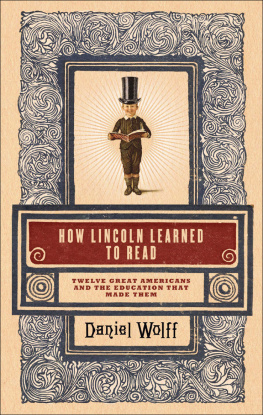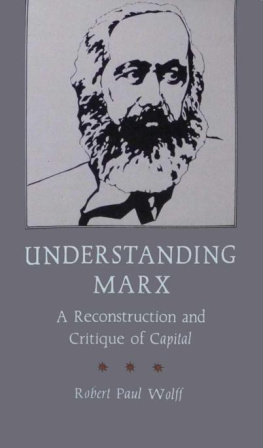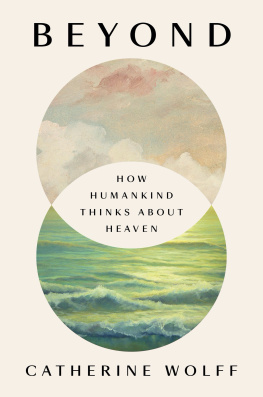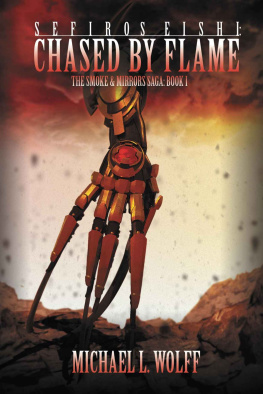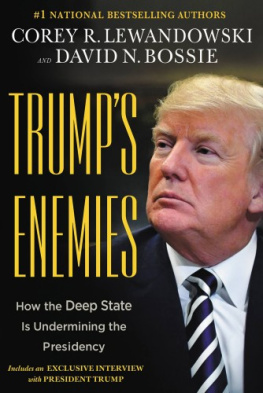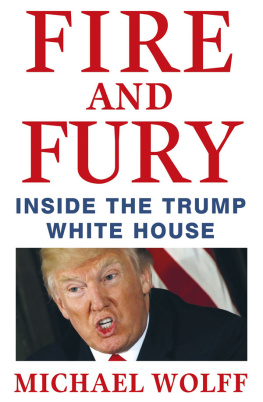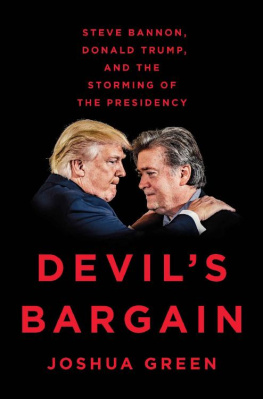
The author and publisher have provided this e-book to you for your personal use only. You may not make this e-book publicly available in any way. Copyright infringement is against the law. If you believe the copy of this e-book you are reading infringes on the authors copyright, please notify the publisher at: us.macmillanusa.com/piracy.
For Victoria and Louise, mother and daughter
The reason to write this book could not be more obvious. With the inauguration of Donald Trump on January 20, 2017, the United States entered the eye of the most extraordinary political storm since at least Watergate. As the day approached, I set out to tell this story in as contemporaneous a fashion as possible, and to try to see life in the Trump White House through the eyes of the people closest to it.
This was originally conceived as an account of the Trump administrations first hundred days, that most traditional marker of a presidency. But events barreled on without natural pause for more than two hundred days, the curtain coming down on the first act of Trumps presidency only with the appointment of retired general John Kelly as the chief of staff in late July and the exit of chief strategist Stephen K. Bannon three weeks later.
The events Ive described in these pages are based on conversations that took place over a period of eighteen months with the president, with most members of his senior staffsome of whom talked to me dozens of timesand with many people who they in turn spoke to. The first interview occurred well before I could have imagined a Trump White House, much less a book about it, in late May 2016 at Trumps home in Beverly Hillsthe then candidate polishing off a pint of Hagen-Dazs vanilla as he happily and idly opined about a range of topics while his aides, Hope Hicks, Corey Lewandowski, and Jared Kushner, went in and out of the room. Conversations with members of the campaigns team continued through the Republican Convention in Cleveland, when it was still hardly possible to conceive of Trumps election. They moved on to Trump Tower with a voluble Steve Bannonbefore the election, when he still seemed like an entertaining oddity, and later, after the election, when he seemed like a miracle worker.
Shortly after January 20, I took up something like a semipermanent seat on a couch in the West Wing. Since then I have conducted more than two hundred interviews.
While the Trump administration has made hostility to the press a virtual policy, it has also been more open to the media than any White House in recent memory. In the beginning, I sought a level of formal access to this White House, something of a fly-on-the-wall status. The president himself encouraged this idea. But, given the many fiefdoms in the Trump White House that came into open conflict from the first days of the administration, there seemed no one person able to make this happen. Equally, there was no one to say Go away. Hence I became more a constant interloper than an invited guestsomething quite close to an actual fly on the wallhaving accepted no rules nor having made any promises about what I might or might not write.
Many of the accounts of what has happened in the Trump White House are in conflict with one another; many, in Trumpian fashion, are baldly untrue. Those conflicts, and that looseness with the truth, if not with reality itself, are an elemental thread of the book. Sometimes I have let the players offer their versions, in turn allowing the reader to judge them. In other instances I have, through a consistency in accounts and through sources I have come to trust, settled on a version of events I believe to be true.
Some of my sources spoke to me on so-called deep background, a convention of contemporary political books that allows for a disembodied description of events provided by an unnamed witness to them. I have also relied on off-the-record interviews, allowing a source to provide a direct quote with the understanding that it was not for attribution. Other sources spoke to me with the understanding that the material in the interviews would not become public until the book came out. Finally, some sources spoke forthrightly on the record.
At the same time, it is worth noting some of the journalistic conundrums that I faced when dealing with the Trump administration, many of them the result of the White Houses absence of official procedures and the lack of experience of its principals. These challenges have included dealing with off-the-record or deep-background material that was later casually put on the record; sources who provided accounts in confidence and subsequently shared them widely, as though liberated by their first utterances; a frequent inattention to setting any parameters on the use of a conversation; a sources views being so well known and widely shared that it would be risible not to credit them; and the almost samizdat sharing, or gobsmacked retelling, of otherwise private and deep-background conversations. And everywhere in this story is the presidents own constant, tireless, and uncontrolled voice, public and private, shared by others on a daily basis, sometimes virtually as he utters it.
For whatever reason, almost everyone I contactedsenior members of the White House staff as well as dedicated observers of itshared large amounts of time with me and went to great effort to help shed light on the unique nature of life inside the Trump White House. In the end, what I witnessed, and what this book is about, is a group of people who have struggled, each in their own way, to come to terms with the meaning of working for Donald Trump.
I owe them an enormous debt.
The evening began at six-thirty, but Steve Bannon, suddenly among the worlds most powerful men and now less and less mindful of time constraints, was late.
Bannon had promised to come to this small dinner arranged by mutual friends in a Greenwich Village town house to see Roger Ailes, the former head of Fox News and the most significant figure in right-wing media and Bannons sometime mentor. The next day, January 4, 2017little more than two weeks before the inauguration of his friend Donald Trump as the forty-fifth presidentAiles would be heading to Palm Beach, into a forced, but he hoped temporary, retirement.
Snow was threatening, and for a while the dinner appeared doubtful. The seventy-six-year-old Ailes, with a long history of leg and hip problems, was barely walking, and, coming in to Manhattan with his wife Beth from their upstate home on the Hudson, was wary of slippery streets. But Ailes was eager to see Bannon. Bannons aide, Alexandra Preate, kept texting steady updates on Bannons progress extracting himself from Trump Tower.
As the small group waited for Bannon, it was Ailess evening. Quite as dumbfounded by his old friend Donald Trumps victory as most everyone else, Ailes provided the gathering with something of a mini-seminar on the randomness and absurdities of politics. Before launching Fox News in 1996, Ailes had been, for thirty years, among the leading political operatives in the Republican Party. As surprised as he was by this election, he could yet make a case for a straight line from Nixon to Trump. He just wasnt sure, he said, that Trump himself, at various times a Republican, Independent, and Democrat, could make the case. Still, he thought he knew Trump as well as anyone did and was eager to offer his help. He was also eager to get back into the right-wing media game, and he energetically described some of the possibilities for coming up with the billion or so dollars he thought he would need for a new cable network.


